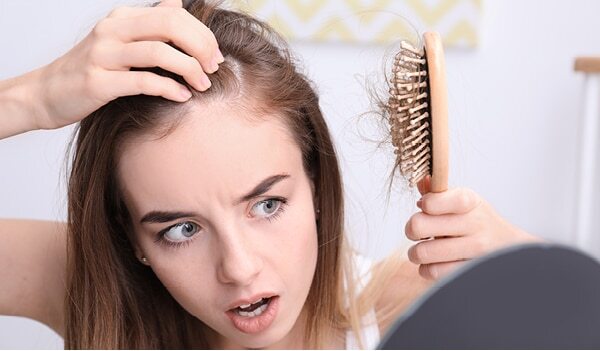One of the most common disorders that affects hair growth is alopecia areata. This is an autoimmune disorder in which a person starts losing hair in patches all over their scalp. This happens when your immune system attacks hair follicles, which results in unprecedented hair loss. Alopecia can strike at any time and the hair loss can either be sudden or gradual. To help you understand this disorder better, we spoke to Dr. Soma Sarkar about it. In this article, Dr. Sarkar explains everything you need to know about this condition, including the causes, symptoms and the best alopecia treatments that can help reverse and slow down this condition. So, without further ado, let's get started...
01What exactly is alopecia areata?

In the words of Dr. Soma Sarkar , "Alopecia areata is a disorder where you lose your hair in circular patches from the scalp, moustache and beard area. It can be a localised disorder or can even extend to other parts of your body. Alopecia can occur over the body as well. Both the sexes can suffer from this and it can also be found in pediatric age groups as well. It's an autoimmune disorder where your own immune cells attack the healthy hair follicles and cause their death, which renders them ineffective for healthy hair growth. As to why the immune cells behave in such an abnormal way, we still don't have too much evidence, but it can get triggered due to stress." There have been instances when alopecia has disappeared completely for a while, and then has even recurred after a couple of years. Even though this condition starts with patchy hair loss, it can eventually lead to complete baldness and prevent healthy hair growth. As unfortunate as it is, there is still no cure for alopecia, but with different medical treatments, you can surely prevent more hair loss. And that's exactly what we are going to discuss in this article today.
02Causes of alopecia areata
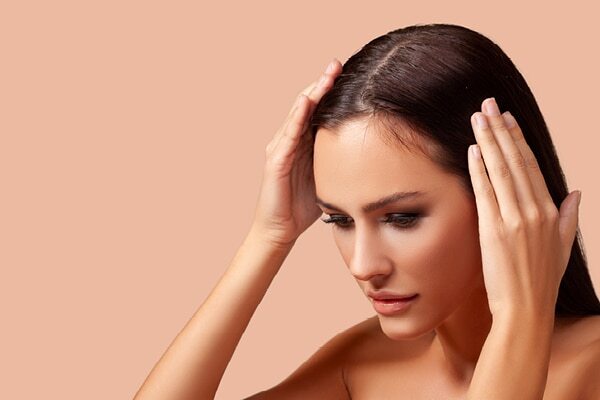
Dr. Soma Sarkar says , "This disorder is caused due to abnormal behavior of the immune cells. It attacks the hair growth cells and destroys them causing alopecia areata." To explain further, alopecia occurs when the white blood cells in your body attack the hair follicles, thereby damaging them and rendering your hair to grow really slow and even stop over time in a few cases. Research claims that even though the cause is unknown, your genes could have a role to play in this. If a close family member has alopecia, then there is a possibility that you could too. Additionally, if you or a close family member has a history of other autoimmune disorders such as being hyperallergic or having thyroiditis or vitiligo, then there is a chance that you could also develop alopecia areata over time.
03Types of alopecia

Alopecia areata –
This type of alopecia is indicated by small, coin-sized patches of hair loss on the scalp.
Alopecia totalis –
When your alopecia areata expands to hair loss on the entire scalp, it becomes alopecia totalis
Alopecia universalis –
If hair loss expands to other parts of the body such as eyebrows, lashes, chest, pubic area, etc., other than just the scalp, then it is called alopecia universalis.
Diffuse alopecia areata –
This type of alopecia is very similar to male and female pattern hair loss. If you notice sudden hair thinning, hair loss or balding all over the scalp (and not in patches), then you may have diffuse alopecia areata.
Ophiasis alopecia –
If the hair loss happens only along the sides and back of the scalp, then it is called ophiasis alopecia.
04Alopecia treatments
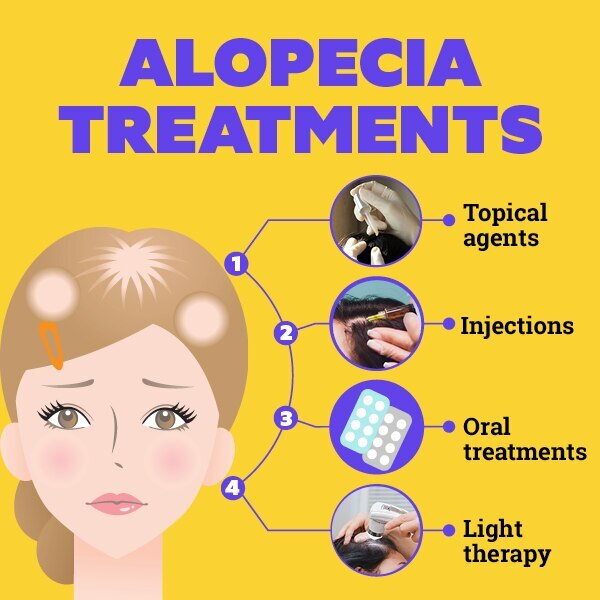
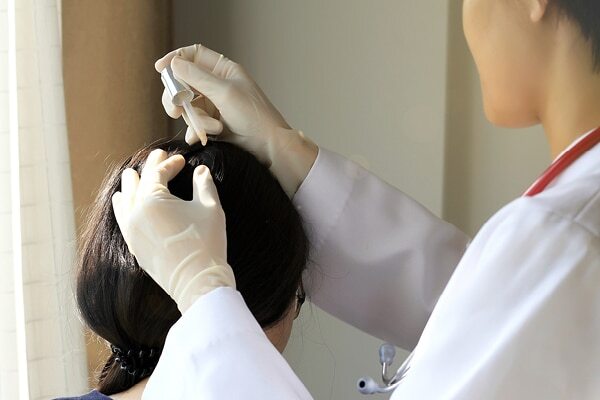
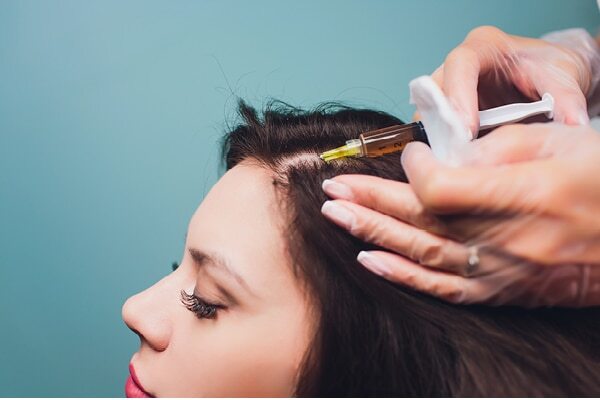

As discussed earlier, there is no cure yet for alopecia, but you can undergo certain treatments that can either help slow down hair loss, prevent balding and even regrow your hair over a period of time. Dr. Sarkar adds , "There are medical treatments available in the form of oral and topical therapy. Sometimes we have to adhere to minimally invasive treatments too, if the case is resistant. The most common drugs given to slow down alopecia are steroids, immunosuppressants, calcineurin inhibitors and intralesional steroids." Thanks to modern science, there are several topical creams and medicines that you can apply to your scalp to stop hair loss and promote the growth of lost hair. Even though there are a few over-the-counter medicines available, it is highly recommended that you speak to a doctor before taking any of these medicines. The most common topical agent that is safe and highly recommended by doctors is minoxidil (Rogaine). This is a fairly common OTC medicinal cream that claims to slow hair loss and promote hair growth. The recommended dosage is usually twice a day on your scalp, beard, eyebrows and it is also quite safe for everyone. The only thing to remember is that minoxidil can take several months to show results, so you will need to be patient. Injections containing steroids is another highly recommended alopecia treatment that a lot of doctors recommend. These injections, however, may not work if you have really severe symptoms and are best for people with mild, patchy alopecia only. In this treatment, which is usually recommended once or twice a month, tiny needles filled with steroids are injected to bare skin on the affected area to regrow new hair. Another alopecia treatment is taking oral medicines to help regrow hair. The common medicine given is cortisone tablets, which is studied to be quite effective on people suffering from extensive alopecia. This medicine works by blocking your immune system's response against attacking the follicles, and it may have certain serious side effects such as high blood pressure, liver and kidney damage to name a few. Therefore, it is not recommended to take these medicines for a longer period of time. Always speak to your doctor first and stick to the prescribed dosage to prevent any adverse issues. In extreme cases of alopecia, doctors sometimes recommend light therapy to help regrow new hair. This therapy, also known as photochemotherapy or phototherapy, uses a combination of oral supplements and UV light to treat alopecia.
05FAQs about alopecia treatment
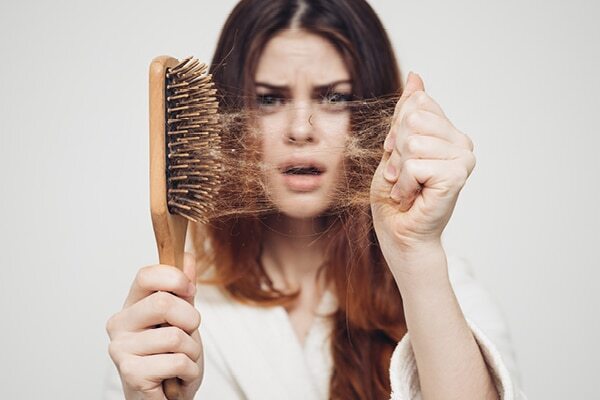
Q. Are there any home remedies to treat alopecia?
**A. **Dr. Sarkar says, "There are no home remedies for this condition. But one can definitely work upon the stress levels for the good response of the treatment given. Positive mindset definitely helps and therefore undergoing counseling and other positive motivation could be really helpful."
Q. How long does it take for alopecia to go away?
**A. **This is something that is totally subjective and largely depends on each individual. In a lot of cases, the signs of alopecia reduced in just a few months without any treatment. But in some cases, the episodes of hair loss lasted for several months and even years.
Q. Are there any symptoms of alopecia other than hair loss?
**A. **Dr. Soma Sarkar says, "Apart from hair loss, sometimes you can have systemic involvement and skin lesions too, which can be like a lichen planus condition." Therefore, it is always best to consult your doctor if you notice your skin or hair looking and feeling weird. This is because, the faster to know about the condition, the easier it is to treat.
Q. What are the most common types of alopecia in women?
**A. **"In women, the alopecia patches can be present over the scalp in singular or multiple patches. It can also occur on the eyebrows and eyelashes. In such cases one has to also investigate for other autoimmune disorders like thyroid, morphed, lupus, fungal and bacterial infection or some other type of injury."

